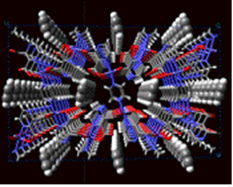Computational science
Computational study on the properties and microscopic kinetics of hydrogen storage materials


Scope
We investigate the fundamental mechanism of hydrogen storage phenomena by using computer simulation techniques, and will propose guidelines for improving the hydrogen storage properties.
Outlines of our studies are as follows.
- Evaluation of hydrogen storage properties by ab initio techniques.
- Evaluation of storage mechanism and structural stability by large-scale classical MD
- Survey of novel hydrogen storage materials by computer simulation.
- Cooperation between experimental analysis and computer simulation.
- Development of new computational technique and softwares.
Research Themes
1. First-principles simulations for hydrogen absorbing materials
 Using the first-principles calculations based on the molecular orbital (MO), density functional theory (DFT),
and path-integral (PI) methods, hydrogen absorbing sites and electronic structures in hydrogen storage materials are investigated.
Especially, we will analyze the effects of element substitution, local structures, and hydrogen absorption/desorption processes
in Zeolite-Templated Carbon (ZTC) in collaboration with the experimental group (thema 5), and try to improve its hydrogen storage properties.
Using the first-principles calculations based on the molecular orbital (MO), density functional theory (DFT),
and path-integral (PI) methods, hydrogen absorbing sites and electronic structures in hydrogen storage materials are investigated.
Especially, we will analyze the effects of element substitution, local structures, and hydrogen absorption/desorption processes
in Zeolite-Templated Carbon (ZTC) in collaboration with the experimental group (thema 5), and try to improve its hydrogen storage properties.
2. Molecular dynamics study on the mechanism of hydrogen storage
 Large-scale phenomena concerning to the hydrogen storage are analyzed by classical molecular dynamics.
We try to clarify the interaction between absorbed hydrogen atoms and various structural defects
(vacancy, dislocation, grain boundary, etc.) by using realistic models within a reasonable accuracy.
Large-scale phenomena concerning to the hydrogen storage are analyzed by classical molecular dynamics.
We try to clarify the interaction between absorbed hydrogen atoms and various structural defects
(vacancy, dislocation, grain boundary, etc.) by using realistic models within a reasonable accuracy.
3. Molecular Dynamics Study of Structural Stability in Hydrogen-Storage Materials
 It is important to discuss the dynamical effect in the structural stability of hydrogen-storage materials,
in addition to the energetic effect. We analyze the structural stability and hydrogen diffusion process
at atomic level by the first principle and molecular dynamics calculations.
The target is the elastic instability of metallic lattice induced by hydrogenation and the phase transition of hydrogen diffusion in hydrogen storage materials.
The computer graphics technique is used to understand the dynamical process in the materials.
It is important to discuss the dynamical effect in the structural stability of hydrogen-storage materials,
in addition to the energetic effect. We analyze the structural stability and hydrogen diffusion process
at atomic level by the first principle and molecular dynamics calculations.
The target is the elastic instability of metallic lattice induced by hydrogenation and the phase transition of hydrogen diffusion in hydrogen storage materials.
The computer graphics technique is used to understand the dynamical process in the materials.
4. Simulation Research on Novel Hydrogen Storage Materials
 Interest in hydrogen clathrate hydrates as potential hydrogen storage materials has risen recently after a report that the clathrate hydrate of structure
CS-II can store around 4.96 wt% of hydrogen at 220MPa and 234 K. It is well known that there are several types of gas hydrate structures with different cage shapes.
Therefore, for practical application of gas clathrates as hydrogen storage materials, it is important to know the region of stability of these compounds as well as
the hydrogen concentration at various pressures and temperatures.
Interest in hydrogen clathrate hydrates as potential hydrogen storage materials has risen recently after a report that the clathrate hydrate of structure
CS-II can store around 4.96 wt% of hydrogen at 220MPa and 234 K. It is well known that there are several types of gas hydrate structures with different cage shapes.
Therefore, for practical application of gas clathrates as hydrogen storage materials, it is important to know the region of stability of these compounds as well as
the hydrogen concentration at various pressures and temperatures.
5. Understanding of the Hydrogen Storage Mechanism through Spillover by Using Zeolite-Templated Carbon as a Model Material
 The use of spillover H together with physisorbed H2 has great promise for a new type of hydrogen storage mechanism in porous materials.
With the help of computer simulation, we try to reveal the storage mechanism of spillover H in the zeolite-templated carbon,
whose molecular structure is uniform and ordered (see a right figure) in contrast to random and complicated structures in activated carbons.
The unique features of the zeolite-templated carbon enable us to directly compare the simulation results with the experimental ones,
which makes this material ideal as a model for computer simulation.
The use of spillover H together with physisorbed H2 has great promise for a new type of hydrogen storage mechanism in porous materials.
With the help of computer simulation, we try to reveal the storage mechanism of spillover H in the zeolite-templated carbon,
whose molecular structure is uniform and ordered (see a right figure) in contrast to random and complicated structures in activated carbons.
The unique features of the zeolite-templated carbon enable us to directly compare the simulation results with the experimental ones,
which makes this material ideal as a model for computer simulation.
6. Simulation Study on the Dynamical Behavior and Electronic States of Hydrogen Storage Materials
 The dynamical behavior and electronic states of hydrogen storage materials are investigated using ab initio molecular dynamics simulations
in order to clarify the microscopic mechanism of hydrogen absorption and desorption. So far the dynamical behavior of hydrogen desorption is
investigated for the reaction of Li2H2 cluster with NH3 molecule (see the figure). Other alkali-hydrides-NH3 systems and non-metallic systems
will be also studied to improve the hydrogen storage properties and to search for novel non-metallic hydrogen storage materials with better quality.
The dynamical behavior and electronic states of hydrogen storage materials are investigated using ab initio molecular dynamics simulations
in order to clarify the microscopic mechanism of hydrogen absorption and desorption. So far the dynamical behavior of hydrogen desorption is
investigated for the reaction of Li2H2 cluster with NH3 molecule (see the figure). Other alkali-hydrides-NH3 systems and non-metallic systems
will be also studied to improve the hydrogen storage properties and to search for novel non-metallic hydrogen storage materials with better quality.
7. Electronic Structure and Structural Stability of Hydrogen Storage Materials
 Using the first-principles approach, the electronic structure and structural stability of light-element hydrides,
which are highly expected for the application to hydrogen storage, are studied.
It aims at the design of new hydrogen-storage materials by discussing the chemical trends of element substitution and the electronic properties under high pressure.
Using the first-principles approach, the electronic structure and structural stability of light-element hydrides,
which are highly expected for the application to hydrogen storage, are studied.
It aims at the design of new hydrogen-storage materials by discussing the chemical trends of element substitution and the electronic properties under high pressure.
Members
- Nanosystem Research Institute, AIST
- Tohoku University
- Hiroshima University
- Osaka University